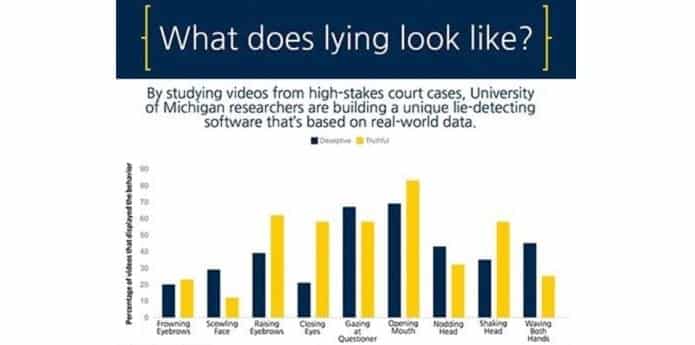Unique lie-detecting software can spot liars by examining gestures and words
Researchers from University of Michigan have created a foolproof software to detect liars. The present crop of lie detectors used by the law enforcement agencies use eye contact, confidence and well-thought out answers to find out if someone is lying. The researchers from University of Michigan have added facial grimace, too much hand gestures and the use of fillers as signals given out by untruthful people.
Their new lie-detecting model considers both the person’s words and gestures, and unlike a polygraph, it doesn’t need to touch the speaker in order to work. The software is accurate 75% of the time, compares to human judgement, which proved to be accurate only 50% of the time.
Earlier studies indicated that giving a hesitant answer and avoiding eye contact are foolproof signs of lying. However, the University of Michigan found out that the exact opposite true.
“In laboratory experiments, it’s difficult to create a setting that motivates people to truly lie. The stakes are not high enough,” lead researcher Rada Mihalcea said. “We can offer a reward if people can lie well–pay them to convince another person that something false is true. But in the real world there is true motivation to deceive.”
It is hoped that once developed further, the software could become an effective lie-detection tool in fields such as law, security and mental health. The videos were media coverage of a number of 120 court trials.
The team also used some video footage from The Innocence Project website, a non-profit legal organisation committed to exonerating wrongly convicted people. “But in the real world there is true motivation to deceive”, said Mihalcea. They also counted the gestures in the videos using a standard coding scheme for interpersonal interactions that scores nine different motions of the head, eyes, brow, mouth and hands.
Then they fed the data into their system, allowing it to sort the videos. Well, sadly it appears the reality is that the best liars will, in fact, hold eye contact and lie straight to your face.
“There are clues that humans give naturally when they are being deceptive, but we’re not paying close enough attention to pick them up,” Mihalcea said. “We’re not counting how many times a person says ‘I’ or looks up. We’re focusing on a higher level of communication.”
The other big step they’re working on is letting the computer classify gestures itself – similar to technology explored by researchers in Finland – which is now done by the researchers. The work was funded by the National Science Foundation, John Templeton Foundation and Defense Advanced Research Projects Agency.

